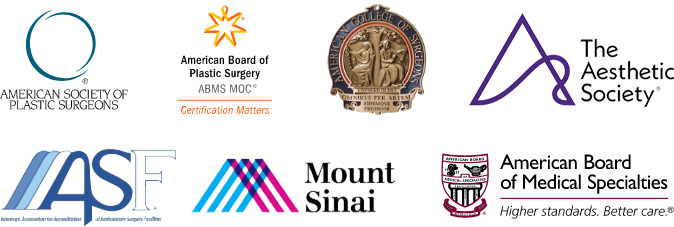As a board-certified plastic surgeon in New York City, I’ve had the privilege of performing upper blepharoplasty for countless patients, helping them achieve both functional and aesthetic transformations. This procedure is not just about removing excess skin; it’s about tailoring a result that complements the individual’s natural beauty while addressing specific concerns. Here’s an overview of what upper blepharoplasty entails, from a plastic surgeon’s perspective.
Why You Might Consider Upper Eyelid Surgery
The skin of the upper eyelids is delicate and prone to showing the effects of aging. Over time, loss of elasticity can lead to sagging, which not only creates a tired appearance but may also obstruct peripheral vision. Upper blepharoplasty corrects these issues by:
- Enhancing Functionality: Many patients report significant improvement in peripheral vision after surgery.
- Rejuvenating Appearance: The eyes appear brighter and more youthful, contributing to an overall refreshed look.
For me, the goal is always twofold: to restore form and function while ensuring that the results appear natural and harmonious. To ensure that natural look, I often also combine blepharoplasty with facelift surgery for full-face rejuvenation.
Patient-Centric Planning
Every successful outcome begins with a thorough consultation. This step is vital for:
- Understanding the Patient’s Goals: Each person has unique reasons for seeking blepharoplasty—whether it’s for functional improvement, aesthetic enhancement, or both.
- Detailed Evaluation: During the consultation, I evaluate eyelid anatomy, skin quality, and overall facial proportions to design a surgical plan tailored to the individual.
- Setting Realistic Expectations: Open communication ensures that patients understand what the procedure can and cannot achieve, which is key to satisfaction.
The Surgical Process
Upper blepharoplasty is a precise and meticulous procedure, typically performed under local or general anesthesia, depending on patient preference. The steps include:
- Marking the incision line along the natural crease to ensure scars are inconspicuous.
- Removing excess skin, fat, and muscle to achieve a balanced contour.
- Ensuring symmetry and natural appearance through careful technique.
The procedure usually lasts 1 to 2 hours. My focus throughout is on precision, safety, and achieving results that complement the patient’s unique facial features.
Recovery and Postoperative Care
Recovery from eyelid surgery is a collaborative process between the patient and me. I provide detailed instructions to ensure optimal healing, which include:
- Swelling and Bruising Management: Use cold compresses and sleep with your head elevated.
- Activity Modifications: Avoiding strenuous activities. Protect the treated area from sun exposure.
- Follow-Up Visits: Regular checkups allow me to monitor healing and address any concerns promptly.
Most patients are able to return to normal activities within 10 to 14 days, although subtle improvements continue over several months.
Who Is a Good Candidate for an Upper Eyelid Lift?
Not every patient is an ideal candidate for an upper eyelid lift. Factors I consider include:
- Extent of Drooping: The presence of excess skin that impairs vision or affects aesthetics is an important consideration.
- Overall Health: Candidates should be in good health to minimize surgical risks.
- Realistic Goals: Patients should understand the potential outcomes of surgery.
Safety and Risks
As with any surgery, there are risks, but I minimize them with:
- Comprehensive preoperative assessments.
- Advanced surgical techniques.
- Rigorous postoperative care.
Potential complications, such as dry eyes or asymmetry, are rare under the care of an experienced plastic surgeon. My priority is always the patient’s safety and satisfaction.
Why Choose a Board-Certified Plastic Surgeon
Board certification signifies a commitment to excellence in patient care. My approach combines technical expertise with an artistic eye, ensuring results that are both functional and beautiful. Patients often tell me that their confidence soars after surgery, which is one of the most rewarding aspects of my work.
Find out how to choose a good plastic surgeon in my related blog post.
Your Journey to Brighter, Refreshed Eyes
Upper blepharoplasty is more than a cosmetic procedure; it’s a path to rejuvenation and enhanced quality of life. From the initial consultation to the final follow-up, my aim is to guide patients through a seamless and rewarding journey.
If you’re considering upper blepharoplasty, I invite you to request a consultation online or call my office at (212) 249-4020 to book a consultation directly. Together, we can explore your goals and determine how this procedure can help you achieve a refreshed, confident appearance.
Upper Blepharoplasty FAQ
What is upper blepharoplasty, and how does it differ from other eyelid surgeries?
Upper blepharoplasty focuses solely on the upper eyelids, targeting excess skin and tissue that may cause drooping. Other eyelid surgeries, like lower blepharoplasty, address issues such as under eye bags or wrinkles.
How long does it take to see results after upper blepharoplasty?
Initial results are visible within 1 to 2 weeks, but full healing and optimal results typically take several months as swelling subsides.
Will the scars from upper blepharoplasty be noticeable?
Scars are minimal and usually concealed within the natural crease of the eyelid. Over time, they fade significantly and become almost invisible.
How can I prepare for my upper blepharoplasty procedure?
Preparation involves avoiding blood-thinning medications, arranging transportation, and following Dr. Sterry’s specific preoperative guidelines. Staying hydrated and eating a nutritious diet beforehand is also recommended.
What should I expect during the recovery period?
Recovery includes mild swelling, bruising, and temporary discomfort. Most patients resume normal activities within 10 to 14 days, with full recovery in about 6 weeks.
Are there nonsurgical alternatives to upper blepharoplasty?
Nonsurgical options, such as BOTOX® or dermal fillers, can temporarily improve the appearance of the eyelid area. However, these alternatives cannot address excess skin or provide the long-lasting results of surgery.
How do I know if I’m a good candidate for upper blepharoplasty?
If you have drooping upper eyelids, vision impairment due to excess skin, or desire a more youthful appearance, you may be a good candidate. A consultation with Dr. Sterry can determine your suitability.
Medical References
- Upper eyelid blepharoplasty: Improved the overall periorbital aesthetic – Dove Medical Press https://www.dovepress.com/upper-eyelid-blepharoplasty-improved-the-overall-periorbital-aesthetic-peer-reviewed-fulltext-article-CCID
- Blepharoplasty – Mayo Clinic https://www.mayoclinic.org/tests-procedures/blepharoplasty/about/pac-20385174
- Upper Eyelid Blepharoplasty – StatPearls – NCBI Bookshelf https://www.ncbi.nlm.nih.gov/books/NBK537078/
- Functional outcomes of upper eyelid blepharoplasty: A systematic review – ResearchGate https://www.researchgate.net/publication/329120326_Functional_outcomes_of_upper_eyelid_blepharoplasty_A_systematic_review
- Blepharoplasty – StatPearls – NCBI Bookshelf https://www.ncbi.nlm.nih.gov/books/NBK482381/










Leave a Reply